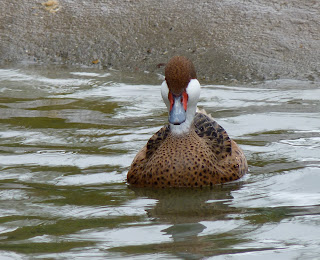It was cold and rainy today. After the conference ended in the early afternoon, my colleagues and I went to the San Diego Zoo in Balboa Park. We got caught out in two or three heavy rain showers. We could actually see our breath. This is not what any of us expected for our trip to San Diego. With all the rain they've had here the area is incredibly green and beautiful. My colleague found out from a telephone call to her husband that it is sunny and 60 degrees back in Detroit. That's certainly better weather than we've experienced here for the past two days.
Still managed to get out for a few more birds. On the walk to the beach this American Wigeon (Anas americana) was with a partner in an area near a small bit of water between resort buildings.
In all I saw about a dozen Marbled Godwits (Limosa fedoa) feeding along the sandy shores of the beach areas of our conference's resort island called Paradise Point.
There were also two Willets (Catoptrophorus semipalmatus). I chased this one around and finally got this photo. The above two birds stuck together along the shoreline.
After taking photos of the godwit and the willet I continued walking along the beach. Suddenly a large flock of big black and white birds flew in low over the water looking for a place to land. These were followed by a second large flock. When they finally settled down on a sandy point I estimated there to be about 130 Black Skimmers (Rynchops niger) - comical and completely enjoyable birds. These birds were migrating because their main interest seemed to be rest, not skimming.
The photo is fuzzy around the edges, but this Western Grebe (Aechmophorus occidentalis) was floating quite far out.
This loon was also quite far out into the water for this photograph. I was hoping it to be a Pacific Loon (Gavia pacifica), but when I downloaded the photo I saw that it was a Common Loon (Gavia immer) which also has a significant west coast presence.
I continued to walk along and suddenly this bird flew in seemingly out of no where - Long-billed Curlew (Numenius americanus). What a thrill! It didn't like me taking photos, however, because it flew away almost just as quickly. I had time to snap only a few shots.
Off to the San Diego Zoo this afternoon. Just as we walked in there was a large group of noisy flamingos - don't know which. Very red, very big. In their enclosure, which was essentially open, were a variety of waterfowl - not all property of the zoo. Free flying Mallards, Hooded Mergs, Wood Ducks, Northern Pintail and Cinnamon Teal, Great Egrets were just a few of the fly-in visitors hanging out. There were also two zoo-resident Scarlet Ibis. One of my favorite ducks was a zoo resident - White-cheeked Pintail (Anas bahamensis) - which I have seen in the wild in Peru. I think this is a completely charming duck. Mandarin Ducks (Aix galericulata) were in another enclosure and they are quite possibly the craziest looking duck I have ever seen. All of the zoo ducks were banded, but it was still difficult to discern what would prevent them from escaping.
Lots of non-zoo residents were in the zoo. Those that come easily to mind - Song Sparrows, California Towhees, Black Phoebes and none other than Anna's Hummingbirds were everywhere. Again, I'm struck by how different this Song Sparrow (Melospiza melodia) appears.
Back to Paradise Point for a final meal and to collect our luggage for the trip to the airport. I had just enough daylight remaining to capture this photo of a Heermann's Gull (Larus heermanni) in one of the resort ponds. My new favorite gull.
If I counted correctly, I saw 88 species, three of which were life birds. Successful trip. Good trip. Glad to be going home.























































